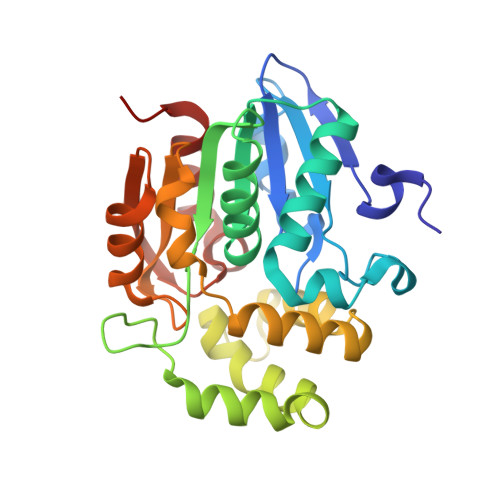A novel strigolactone receptor antagonist provides insights into the structural inhibition, conditioning, and germination of the crop parasite Striga.
Arellano-Saab, A., McErlean, C.S.P., Lumba, S., Savchenko, A., Stogios, P.J., McCourt, P.(2022) J Biological Chem 298: 101734-101734
- PubMed: 35181340
- DOI: https://doi.org/10.1016/j.jbc.2022.101734
- Primary Citation of Related Structures:
7SNU - PubMed Abstract:
Crop parasites of the Striga genera are a major biological deterrent to food security in Africa and are one of the largest obstacles to poverty alleviation on the continent. Striga seeds germinate by sensing small-molecule hormones, strigolactones (SLs), that emanate from host roots. Although SL receptors (Striga hermonthica HYPOSENSITIVE TO LIGHT [ShHTL]) have been identified, discerning their function has been difficult because these parasites cannot be easily grown under laboratory conditions. Moreover, many Striga species are obligate outcrossers that are not transformable, hence not amenable to genetic analysis. By combining phenotypic screening with ShHTL structural information and hybrid drug discovery methods, we discovered a potent SL perception inhibitor for Striga, dormirazine (DOZ). Structural analysis of this piperazine-based antagonist reveals a novel binding mechanism, distinct from that of known SLs, blocking access of the hormone to its receptor. Furthermore, DOZ reduces the flexibility of protein-protein interaction domains important for receptor signaling to downstream partners. In planta, we show, via temporal additions of DOZ, that SL receptors are required at a specific time during seed conditioning. This conditioning is essential to prime seed germination at the right time; thus, this SL-sensitive stage appears to be critical for adequate receptor signaling. Aside from uncovering a function for ShHTL during seed conditioning, these results suggest that future Ag-Biotech Solutions to Striga infestations will need to carefully time the application of antagonists to exploit receptor availability and outcompete natural SLs, critical elements for successful parasitic plant invasions.
- Department of Cell and Systems Biology, University of Toronto, Toronto, Canada; Department of Chemical Engineering and Applied Chemistry, University of Toronto, Toronto, Ontario, Canada.
Organizational Affiliation:





















